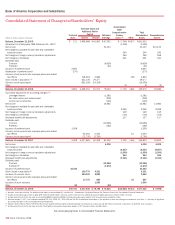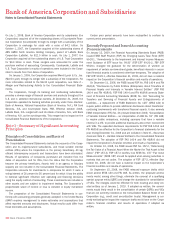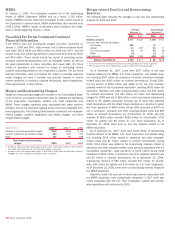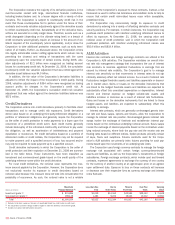Bank of America 2008 Annual Report Download - page 127
Download and view the complete annual report
Please find page 127 of the 2008 Bank of America annual report below. You can navigate through the pages in the report by either clicking on the pages listed below, or by using the keyword search tool below to find specific information within the annual report.on an individual loan basis. Loans subject to individual reviews are ana-
lyzed and segregated by risk according to the Corporation’s internal risk
rating scale. These risk classifications, in conjunction with an analysis of
historical loss experience, current economic conditions, industry perform-
ance trends, geographic or obligor concentrations within each portfolio
segment, and any other pertinent information (including individual valu-
ations on nonperforming loans in accordance with SFAS No. 114,
“Accounting by Creditors for Impairment of a Loan,” (SFAS 114)) result in
the estimation of the allowance for credit losses. The historical loss expe-
rience is updated quarterly to incorporate the most recent data reflective
of the current economic environment.
If necessary, a specific allowance for loan and lease losses is estab-
lished for individual impaired commercial loans. A loan is considered
impaired when, based on current information and events, it is probable
that the Corporation will be unable to collect all amounts due, including
principal and interest, according to the contractual terms of the agree-
ment, and once a loan has been identified as individually impaired,
management measures impairment in accordance with SFAS 114.
Individually impaired loans are measured based on the present value of
payments expected to be received, observable market prices, or for loans
that are solely dependent on the collateral for repayment, the estimated
fair value of the collateral. If the recorded investment in impaired loans
exceeds the present value of payments expected to be received, a
specific allowance is established as a component of the allowance for
loan and lease losses.
SOP 03-3 requires acquired impaired loans be recorded at fair value
and prohibits “carrying over” or the creation of valuation allowances in the
initial accounting of loans acquired in a transfer that are within the scope
of this SOP. The prohibition of the valuation allowance carryover applies
to the purchase of an individual loan, a pool of loans, a group of loans,
and loans acquired in a purchase business combination. For more
information on the SOP 03-3 portfolio associated with the acquisition of
Countrywide, see Note 6 – Outstanding Loans and Leases to the Con-
solidated Financial Statements.
The allowance for loan and lease losses includes two components
which are allocated to cover the estimated probable losses in each loan
and lease category based on the results of the Corporation’s detailed
review process described above. The first component covers those
commercial loans that are either nonperforming or impaired. The second
component covers consumer loans and leases, and performing commer-
cial loans and leases. Included within this second component of the
allowance for loan and lease losses and determined separately from the
procedures outlined above are reserves which are maintained to cover
uncertainties that affect the Corporation’s estimate of probable losses
including domestic and global economic uncertainty and large single
name defaults. Management evaluates the adequacy of the allowance for
loan and lease losses based on the combined total of these two compo-
nents.
In addition to the allowance for loan and lease losses, the Corporation
also estimates probable losses related to unfunded lending commit-
ments, such as letters of credit and financial guarantees, and binding
unfunded loan commitments. The reserve for unfunded lending commit-
ments excludes commitments measured at fair value in accordance with
SFAS 159. Unfunded lending commitments are subject to individual
reviews and are analyzed and segregated by risk according to the Corpo-
ration’s internal risk rating scale. These risk classifications, in con-
junction with an analysis of historical loss experience, utilization
assumptions, current economic conditions, performance trends within
specific portfolio segments and any other pertinent information, result in
the estimation of the reserve for unfunded lending commitments.
The allowance for credit losses related to the loan and lease portfolio
is reported separately on the Consolidated Balance Sheet whereas the
allowance for credit losses related to the reserve for unfunded lending
commitments is reported on the Consolidated Balance Sheet in accrued
expenses and other liabilities. Provision for credit losses related to the
loan and lease portfolio and unfunded lending commitments is reported
in the Consolidated Statement of Income in the provision for credit loss-
es.
Nonperforming Loans and Leases, Charge-offs and
Delinquencies
In accordance with the Corporation’s policies, non-bankrupt credit card
loans, and open-end unsecured consumer loans are charged off no later
than the end of the month in which the account becomes 180 days past
due. The outstanding balance of real estate secured loans that is in
excess of the property value, less cost to sell, are charged off no later
than the end of the month in which the account becomes 180 days past
due. Personal property secured loans are charged off no later than the
end of the month in which the account becomes 120 days past due.
Accounts in bankruptcy are charged off for credit card and certain
open-end unsecured accounts 60 days after bankruptcy notification. For
secured products, accounts in bankruptcy are written down to the
collateral value, less cost to sell, by the end of the month the account
becomes 60 days past due. Only real estate secured accounts are gen-
erally placed into nonaccrual status and classified as nonperforming at
90 days past due. These loans may be restored to performing status
when all principal and interest is current and full repayment of the remain-
ing contractual principal and interest is expected, or when the loan other-
wise becomes well-secured and is in the process of collection. Consumer
loans whose contractual terms have been restructured in a manner which
grants a concession to a borrower experiencing financial difficulties where
the Corporation does not receive adequate compensation are considered
troubled debt restructurings.
Commercial loans and leases, excluding business card loans, that are
past due 90 days or more as to principal or interest, or where reasonable
doubt exists as to timely collection, including loans that are individually
identified as being impaired, are generally classified as nonperforming
unless well-secured and in the process of collection. Loans whose con-
tractual terms have been restructured in a manner which grants a con-
cession to a borrower experiencing financial difficulties, without
compensation on restructured loans, are classified as nonperforming until
the loan is performing for an adequate period of time under the
restructured agreement. In situations where the Corporation does not
receive adequate compensation, the restructuring is considered a trou-
bled debt restructuring. Interest accrued but not collected is reversed
when a commercial loan is classified as nonperforming. Interest collec-
tions on commercial nonperforming loans and leases for which the ulti-
mate collectability of principal is uncertain are applied as principal
reductions; otherwise, such collections are credited to income when
received. Commercial loans and leases may be restored to performing
status when all principal and interest is current and full repayment of the
remaining contractual principal and interest is expected, or when the loan
otherwise becomes well-secured and is in the process of collection. Busi-
ness card loans are charged off no later than the end of the month in
which the account becomes 180 days past due or in which 60 days has
elapsed since receipt of notification of bankruptcy filing, whichever comes
first, and are not classified as nonperforming.
The entire balance of a consumer and commercial loan account is
contractually delinquent if the minimum payment is not received by the
specified due date on the customer’s billing statement. Interest and fees
Bank of America 2008
125
























